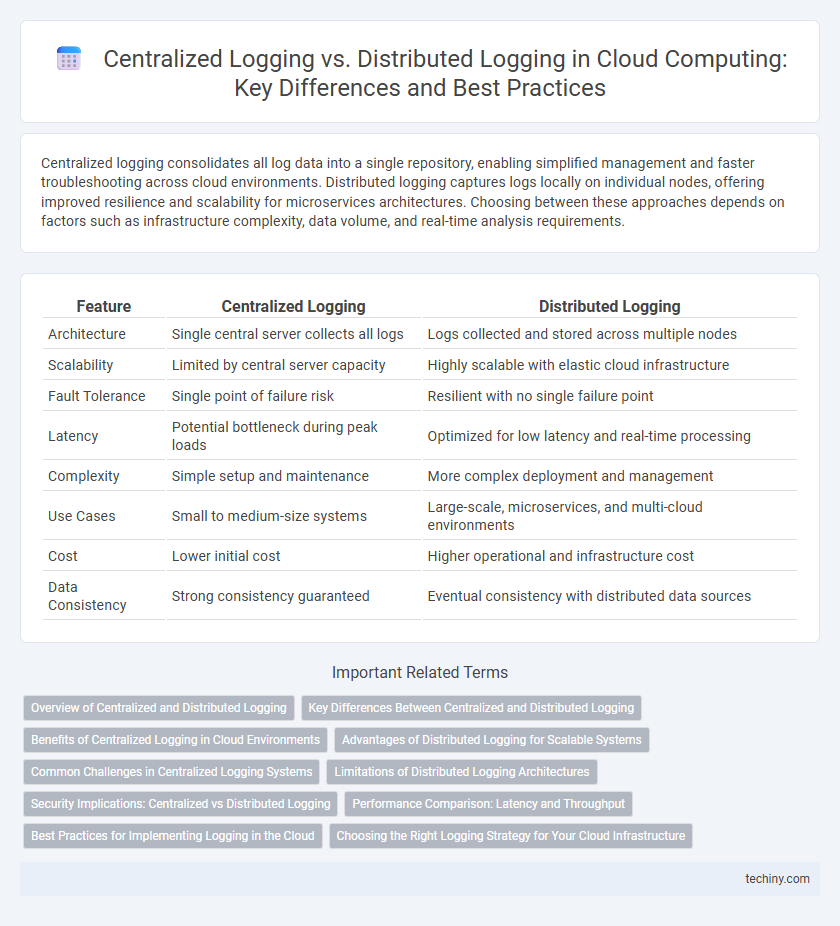Centralized logging consolidates all log data into a single repository, enabling simplified management and faster troubleshooting across cloud environments. Distributed logging captures logs locally on individual nodes, offering improved resilience and scalability for microservices architectures. Choosing between these approaches depends on factors such as infrastructure complexity, data volume, and real-time analysis requirements.
Table of Comparison
| Feature | Centralized Logging | Distributed Logging |
|---|---|---|
| Architecture | Single central server collects all logs | Logs collected and stored across multiple nodes |
| Scalability | Limited by central server capacity | Highly scalable with elastic cloud infrastructure |
| Fault Tolerance | Single point of failure risk | Resilient with no single failure point |
| Latency | Potential bottleneck during peak loads | Optimized for low latency and real-time processing |
| Complexity | Simple setup and maintenance | More complex deployment and management |
| Use Cases | Small to medium-size systems | Large-scale, microservices, and multi-cloud environments |
| Cost | Lower initial cost | Higher operational and infrastructure cost |
| Data Consistency | Strong consistency guaranteed | Eventual consistency with distributed data sources |
Overview of Centralized and Distributed Logging
Centralized logging consolidates all log data from multiple sources into a single repository, enabling simplified analysis, monitoring, and troubleshooting. Distributed logging collects and stores logs independently across various services or nodes, reflecting the architecture of microservices and containerized environments. Both approaches address logging in cloud computing but differ in scalability, fault tolerance, and complexity of log aggregation.
Key Differences Between Centralized and Distributed Logging
Centralized logging aggregates all log data into a single repository, simplifying monitoring and analysis by providing a unified view, while distributed logging collects logs from multiple sources decentralized across various nodes, enhancing fault tolerance and scalability. Centralized systems often rely on powerful storage and indexing solutions such as Elasticsearch, whereas distributed logging leverages decentralized storage and real-time aggregation techniques like Apache Kafka. Key differences include performance impact, ease of log correlation, and resilience, with centralized logging offering straightforward management and distributed logging providing better scalability in microservices architectures.
Benefits of Centralized Logging in Cloud Environments
Centralized logging in cloud environments enhances operational efficiency by aggregating logs from multiple sources into a single, unified platform, simplifying monitoring and troubleshooting. It enables faster detection of anomalies and security threats through comprehensive visibility and correlation of events across distributed systems. Centralized logging also supports compliance and auditing requirements by maintaining consistent, tamper-proof log storage with scalable retention policies.
Advantages of Distributed Logging for Scalable Systems
Distributed logging enhances scalability by aggregating logs from multiple services across various nodes, providing a comprehensive view of system performance in real-time. It improves fault tolerance and reduces bottlenecks compared to centralized logging, enabling faster diagnostics and more efficient resource allocation in large-scale cloud environments. Leveraging distributed logging frameworks like Elasticsearch, Fluentd, and Kibana (EFK) ensures seamless handling of high-volume log data, supporting dynamic scaling and microservices architectures.
Common Challenges in Centralized Logging Systems
Centralized logging systems often face challenges such as scalability limitations due to the high volume of log data aggregated from multiple sources. They also encounter latency issues when processing and querying large datasets, which can delay real-time monitoring and incident response. Additionally, centralized models pose risks related to single points of failure and potential bottlenecks, impacting system reliability and fault tolerance.
Limitations of Distributed Logging Architectures
Distributed logging architectures often face challenges with data consistency and increased latency due to the decentralized nature of log collection across multiple nodes. Scalability issues can arise as the volume of logs grows, leading to potential bottlenecks in data aggregation and querying processes. Security concerns also emerge from the complex distribution paths, making it difficult to ensure end-to-end encryption and integrity of log data.
Security Implications: Centralized vs Distributed Logging
Centralized logging consolidates log data into a single repository, simplifying security monitoring, access control, and audit trails but increases the risk of a single point of failure and targeted attacks. Distributed logging distributes logs across multiple nodes, enhancing fault tolerance and reducing the impact of compromised nodes, though it complicates securing data in transit and maintaining consistent access policies. Implementing encryption, authentication, and robust monitoring is critical in both approaches to mitigate risks and ensure log integrity and confidentiality.
Performance Comparison: Latency and Throughput
Centralized logging systems often exhibit higher latency due to the bottleneck created by funneling all log data through a single aggregation point, which can limit throughput as traffic scales. Distributed logging architectures reduce latency by processing logs locally on multiple nodes, enabling higher overall throughput and improved fault tolerance across cloud environments. Performance optimization in cloud computing favors distributed logging for real-time analytics, thanks to its scalability and lower data transmission overhead.
Best Practices for Implementing Logging in the Cloud
Centralized logging consolidates log data from multiple cloud services into a single repository, enhancing real-time monitoring and simplified analysis, while distributed logging stores logs locally across services, supporting system resilience and fault isolation. Best practices for implementing logging in the cloud include ensuring log data integrity through encryption and access controls, using structured log formats like JSON for easier querying, and integrating with cloud-native monitoring tools such as AWS CloudWatch or Azure Monitor. Implement automated log rotation and retention policies to manage storage costs and comply with regulatory requirements, and implement alerting systems for rapid incident response.
Choosing the Right Logging Strategy for Your Cloud Infrastructure
Choosing the right logging strategy for cloud infrastructure depends on the scale, complexity, and performance requirements of the environment. Centralized logging consolidates logs into a single platform such as Elasticsearch or Splunk, enabling easy searching, monitoring, and alerting for small to medium-sized deployments. Distributed logging distributes log collection and storage across multiple nodes using tools like Fluentd or Loki, improving scalability and fault tolerance for large-scale, microservices-based cloud architectures.
Centralized Logging vs Distributed Logging Infographic

 techiny.com
techiny.com